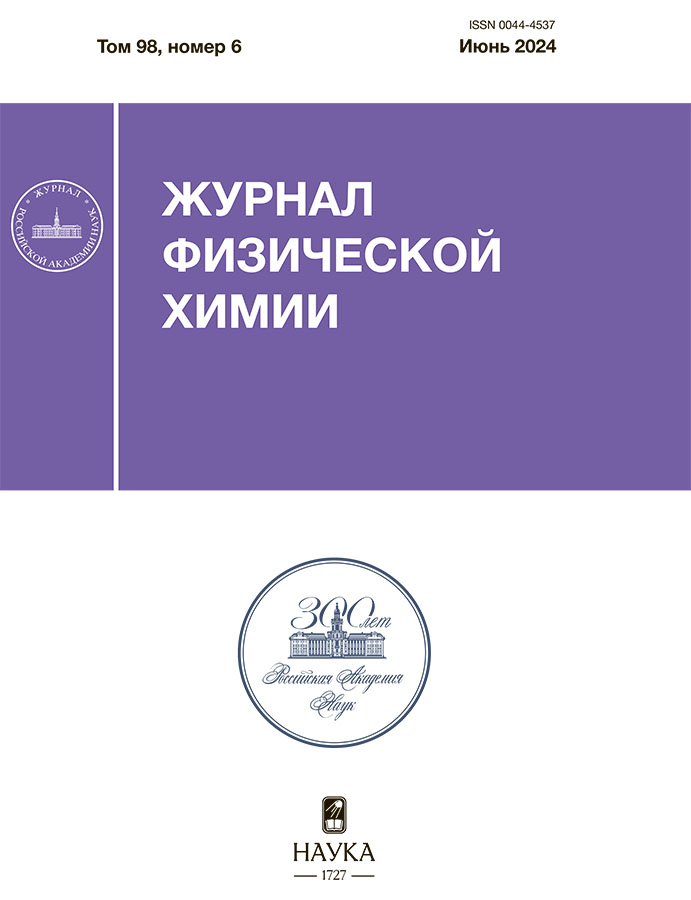Влияние температуры и давления метана на спектральные характеристики полос комбинационного рассеяния н-бутана в диапазоне 300–1100 см–1
- 作者: Таничев А.С.1, Петров Д.В.1,2, Матросов И.И.1, Зарипов А.Р.1
-
隶属关系:
- Институт мониторинга климатических и экологических систем СО РАН
- Национальный исследовательский Томский государственный университет
- 期: 卷 98, 编号 6 (2024)
- 页面: 51-57
- 栏目: ЭКСПЕРИМЕНТАЛЬНАЯ И ТЕОРЕТИЧЕСКАЯ СПЕКТРОСКОПИЯ ГАЗОВОЙ ФАЗЫ
- ##submission.dateSubmitted##: 27.02.2025
- ##submission.datePublished##: 29.12.2024
- URL: https://permmedjournal.ru/0044-4537/article/view/668949
- DOI: https://doi.org/10.31857/S0044453724060094
- EDN: https://elibrary.ru/PXRBUE
- ID: 668949
如何引用文章
详细
Исследованы изменения спектральных характеристик колебательных полос н-бутана в спектральной области 300–1100 см–1 при вариации температуры от 285 до 365 К, а также давления метана в диапазоне 2–40 атм. Установлено, что энтальпия транс–гош-перехода н-бутана в газовой фазе составляет 657±66 кал/моль. Показано, что среда метана в исследуемом диапазоне давлений пренебрежимо мало влияет на конформационное равновесие н-бутана. Определено влияние изменения спектральных характеристик н-бутана на точность измерения состава природного газа с помощью спектроскопии КР.
全文:
作者简介
А. Таничев
Институт мониторинга климатических и экологических систем СО РАН
编辑信件的主要联系方式.
Email: tanichev_aleksandr@mail.ru
俄罗斯联邦, Томск
Д. Петров
Институт мониторинга климатических и экологических систем СО РАН; Национальный исследовательский Томский государственный университет
Email: dpetrov@imces.ru
俄罗斯联邦, Томск; Томск
И. Матросов
Институт мониторинга климатических и экологических систем СО РАН
Email: tanichev_aleksandr@mail.ru
俄罗斯联邦, Томск
А. Зарипов
Институт мониторинга климатических и экологических систем СО РАН
Email: tanichev_aleksandr@mail.ru
俄罗斯联邦, Томск
参考
- Guo J., Luo Z., Liu Q. et al. // Sensors. 2021. V. 21. № 10. P. 3539. https://doi.org/10.3390/s21103539
- Knebl A., Domes C., Domes R. et al. // Anal. Chem. 2021. V. 93. № 30. P. 10546. https://doi.org/10.1021/acs.analchem.1c01500
- Hanf S., Keiner R., Yan D. et al. // Ibid. 2014. V. 86. № 11. P. 5278. https://doi.org/10.1021/ac404162w
- Petrov D.V., Matrosov I.I., Zaripov A.R. et al. // Sensors. 2022. V. 22. № 9. P. 3492. https://doi.org/10.3390/s22093492
- Wang J., Chen W., Wang P. et al. // Opt. Express. 2021. V. 29. № 20. P. 32296. https://doi.org/10.1364/oe.437693
- Bai Y., Xiong D., Yao Z. et al. // J. Raman Spectrosc. 2022. V. 53. № 5. P. 1023. https://doi.org/10.1002/jrs.6320
- ГОСТ 31371.7–2008. Газ природный. Определение состава методом газовой хроматографии с оценкой неопределенности. Часть 7. Методика выполнения измерений молярной доли компонентов.
- Allinger N.L., Fermann J.T., Allen W.D. et al. // J. Chem. Phys. 1997. V. 106. № 12. P. 5143. https://doi.org/10.1063/1.473993
- Rosenthal L., Rabolt J.F., Hummel J. // Ibid. 1982. V. 76. № 2. P. 817. https://doi.org/10.1063/1.443052
- Balabin R.M. // J. Phys. Chem. A. 2009. V. 113, № 6. P. 1012. https://doi.org/10.1021/jp809639s
- Barna D., Nagy B., Csontos J. et al. // J. Chem. Theory Comput. 2012. V. 8, № 2. P. 479. https://doi.org/10.1021/ct2007956
- Whalley E. // Rev. Phys. Chem. Japan. 1980. V. 50. P. 119
- Taniguchi Y. // J. Mol. Struct. 1985. V. 126. P. 241. https://doi.org/10.1016/0022-2860(85)80117-4
- Taniguchi Y., Takaya H., Wong P.T.T. et al. // J. Chem. Phys. 1981. V. 75, № 10. P. 4815. https://doi.org/10.1063/1.441908
- Dare-Edwards M.P., Gardiner D.J., Walker N.A. // Nature. 1985. V. 316, № 6029. P. 614. https://doi.org/10.1038/316614a0
- Kasezawa K., Kato M. // J. Phys. Chem. B. 2009. V. 113, № 25. P. 8607. https://doi.org/10.1021/jp900073p
- Verma A.L., Murphy W.F., Bernstein H.J. // J. Chem. Phys. 1974. V. 60, № 4. P. 1522. https://doi.org/10.1063/1.1681228
- Murphy W.F., Fernández-Sanchez J.M., Raghavachari K. // J. Phys. Chem. 1991. V. 95, № 3. P. 1124. https://doi.org/10.1021/j100156a020
- Kint S., Scherer J.R., Snyder R.G. // J. Chem. Phys. 1980. V. 73, № 6. P. 2599. https://doi.org/10.1063/1.440471
- Petrov D. V., Matrosov I.I., Zaripov A.R. // Opt. Spectrosc. 2018. V. 125, № 1. P. 5. https://doi.org/10.1134/S0030400X18070226
- Tanichev A.S., Petrov D.V. // J. Raman Spectrosc. 2022. V. 53, № 3. P. 654. https://doi.org/10.1002/jrs.6145
- Tanichev A.S., Petrov D.V. // Molecules. 2023. V. 28, № 8. P. 3365. https://doi.org/10.3390/molecules28083365
- Komasa J., Piszczatowski K., Łach G. et al. // J. Chem. Theory Comput. 2011. V. 7, № 10. P. 3105. https://doi.org/10.1021/ct200438t
- Roueff E., Abgrall H., Czachorowski P. et al. // Astron. Astrophys. 2019. V. 630, № May 2020. https://doi.org/10.1051/0004-6361/201936249
- Sung K., Steffens B., Toon G.C. et al. // J. Quant. Spectrosc. Radiat. Transf. 2020. V. 251. P. 107011. https://doi.org/10.1016/j.jqsrt.2020.107011
- Bernath P.F., Bittner D.M., Sibert E.L. // J. Phys. Chem. A. 2019. V. 123, № 29. P. 6185. https://doi.org/10.1021/acs.jpca.9b03321
- Gassler G., Hüttner W. // Zeitschrift fur Naturforsch. – Sect. A J. Phys. Sci. 1990. V. 45, № 2. P. 113. https://doi.org/10.1515/zna-1990-0206
- Kozlov D.N., Smirnov V.V., Volkov S.Y. // Appl. Phys. B. 1989. V. 48. P. 273. https://doi.org/10.1007/BF00694359
- Strekalov M.L., Burshtein A.I. // Chem. Phys. 1981. V. 60. № 1. P. 133. https://doi.org/10.1016/0301-0104(81)80112-7
- Strekalov M.L., Burshtein A.I. // Ibid. 1983. V. 82. № 1–2. P. 11. https://doi.org/10.1016/0301-0104(83)85344-0
- Tanichev A.S., Petrov D.V. // Spectrochim. Acta – Part A Mol. Biomol. Spectrosc. 2023. V. 291. P. 122396. https://doi.org/10.1016/j.saa.2023.122396
- Szasz G.J., Sheppard N., Rank D.H. // J. Chem. Phys. 1948. V. 16. № 7. P. 704. https://doi.org/10.1063/1.1746978
- Sheppard N., Szasz G.J. // Ibid. 1949. V. 17. № 1. P. 86. https://doi.org/10.1063/1.1747059
- Ito K. // J. Am. Chem. Soc. 1953. V. 75. № 10. P. 2430. https://doi.org/10.1021/ja01106a046
- Chen S.S., Wilhoit R.C., Zwolinski B.J. // J. Phys. Chem. Ref. Data. 1975. V. 4. № 4. P. 859. https://doi.org/10.1063/1.555526
- Durig J.R., Compton D.A.C. // J. Phys. Chem. 1979. V. 83. № 2. P. 265. https://doi.org/10.1021/j100465a012
- Compton D.A.C., Montero S., Murphy W.F. // Ibid. 1980. V. 84. № 26. P. 3587. https://doi.org/10.1021/j100463a018
- Colombo L., Zerbi G. // J. Chem. Phys. 1980. V. 73. № 4. P. 2013. https://doi.org/10.1063/1.440298
- Stidham H.D., Durig J.R. // Spectrochim. Acta Part A Mol. Spectrosc. 1986. V. 42. № 2–3. P. 105. https://doi.org/10.1016/0584-8539(86)80169-6
- Durig J.R., Wang A., Beshir W. et al. // J. Raman Spectrosc. 1991. V. 22. № 11. P. 683. https://doi.org/10.1002/jrs.1250221115
- Herrebout W.A., Van Der Veken B.J., Wang A. et al. // J. Phys. Chem. 1995. V. 99. № 2. P. 578. https://doi.org/10.1021/j100002a020
- Petrov D. // Anal. Chem. 2021. V. 93. № 48. P. 16282. https://doi.org/10.1021/acs.analchem.1c03358
补充文件














